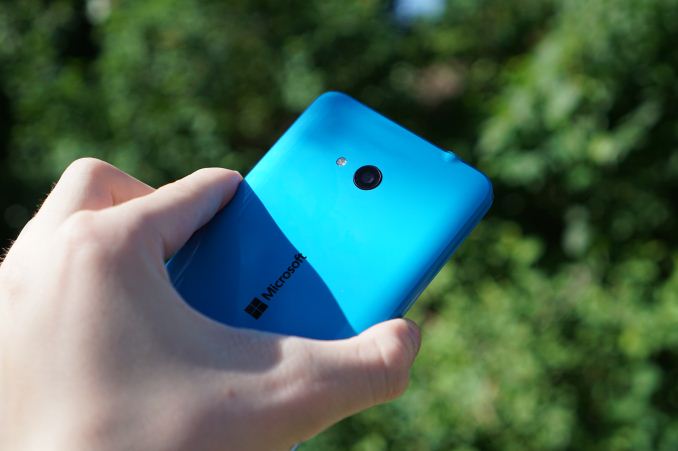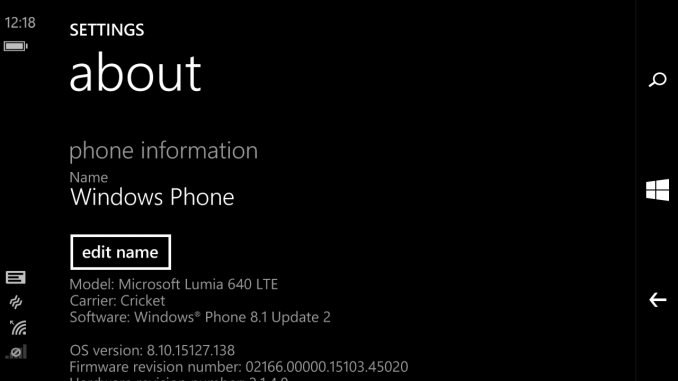The Microsoft Lumia 640 Review
by Brandon Chester on June 9, 2015 8:00 AM EST- Posted in
- Smartphones
- Microsoft
- Mobile
- Lumia
- windows phone 8
Final Words
It's honestly impossible for me to form a single opinion of the Lumia 640. I'm thankful that we don't operate using some sort of rating system where I would have to. Smartphones are comprised of many parts, both hardware and software, and all these things come together and provide an experience. Because smartphones are so appliance like, there's really no way to separate a device's hardware from its software. They need to be evaluated as a whole, and that's why coming to conclusions the Lumia 640 becomes such a difficult task. At the same time, different people value different things in a smartphone. Whether or not it will provide a good experience for you depends on the parts of a smartphone you care about most, and the parts that you're willing to accept compromises on. Because of this. it's worth breaking the Lumia 640 down to its individual parts to see what areas it excels in, and where it falls short.
For me, the best feature of the Lumia 640 is definitely its display. When Brett found that the Lumia 630 shipped with a very accurate LCD in his review, I assumed it had to be some kind of fluke. While we've certainly seen improvement to display accuracy across every price point, the 630 was as accurate as high end flagship devices. However, the Lumia 640 makes it clear to me that people at Nokia, and now at Microsoft, care about having high quality displays on their phones. The greyscale and color accuracy is amazing, and while the pixel density isn't off the charts, it's still much sharper than competing devices with qHD displays.
The Lumia 640's build quality is also something that I think stands out from the competition. Holding it in one hand with the Moto E in the other, it's clear that both are very well made devices for their price. What sets the Lumia 640 ahead is the solid and seamless design of the back cover. There are no lines or tabs that make it obvious that the back cover is removable, and I didn't even realize it myself for a short time. The glossy coating is definitely not my preference, but it goes well with the bright and colorful design of the back covers.
Camera quality has always been a focus with Lumia devices, and I don't think the Lumia 640 is an exception. The 1/4" 8MP camera is by far the best I've used on a device at this price range, and it's clear that much of this comes from the high quality post-processing that Microsoft is doing. There are so many devices that have great camera sensors but completely fail because of poor processing, and Nokia has managed to take a much lesser sensor and produce great photos.
As for the camera app itself, I am only a fan as far as the auto mode is concerned. The interface for manual controls needs work, and the implementation of shutter and ISO control is not useful at all because you can't see a preview of the changes you're making. It's almost like shooting on film, where you just have to pray that the photo turns out well. Most users will stick to the auto shooting mode anyway, but Microsoft should really fix the issues with the manual mode if they intend to offer it.
Unfortunately, the Lumia 640 isn't without its issues. Performance is definitely the first problem that comes to mind. Snapdragon 400 is really starting to show its age, and there are many performance issues that are rooted in software. Internet Explorer is simply not a fast browser, and it's immediately obvious once you try browsing the web with it. Microsoft's scroll speed cap also makes the entire operating system feel slow, and you eventually get to a point where you don't even want to use your phone because the simple task of navigating somewhere takes forever. Some areas like Action Center are also prone to stuttering and sluggish scrolling, which looks very out of place when the rest of the OS is so smooth.
Battery life is also a bit of an issue. It's certainly not bad, but it's not near as good as other devices at this price point like the Moto E. Windows Phone definitely inherited some idle battery life problems during the move from Windows CE to Windows NT, and those were very apparent during my testing as well. Despite the fact that the Lumia 640 was operating without a SIM card, the battery was always low by the early evening even when I hadn't been using it that much.
The last part of the Lumia 640's experience is the software. This is the part that I'm the most conflicted about. When you just consider features, it's clear that Windows Phone has matured significantly from its earliest iterations. Notifications are no longer an issue, and the interface has been refined with the addition of new tile sizes, more space for tiles, and folders. For the average user, the core OS has all the things they'll need from it. At the same time, the OS feels extremely slow, and there isn't anything about it that really stands out from iOS and Android.
Feature parity is fine, but you have to have parity in every respect, including third party applications. In that regard, I wasn't able to make Windows Phone work for me. The apps that do exist are mediocre and trail behind their Android and iOS counterparts on performance, quality and features. The apps that don't exist are the what really ruined things for me though, particularly the lack of Google apps. While I could switch from Drive, it would require a lot of files to be moved over. Hangouts is impossible to switch from, because it involves convincing everyone you speak to using it to switch from it as well. In the end, there are just too many key services that are inaccessible to me on Windows Phone.
In the end, I feel like the Lumia 640 is a great device as far as hardware is concerned, but for me it was let down by its software. I'm sure there are people who won't have the trouble with third party apps that I did, but I'm confident that there are a lot more people who will. Anyone who is thinking about switching over to Windows Phone should definitely take a look at the Windows Store to see if their favorite apps are available. Trying them out on a real device is also useful to check the quality of apps. If you're a user who is fine with Windows Phone and its app selection, then I think you'll enjoy the Lumia 640. It's a really great device for the price, and it's unfortunate that in my case there were just too many missing apps to make the Lumia 640 work for me.














130 Comments
View All Comments
kevloral - Tuesday, June 9, 2015 - link
"After declining sales of Symbian devices, the company decided to go all in with Microsoft's Windows Phone platform"Why is this false mantra repeated again and again? When Nokia decided to go Windows Phone, Symbian devices were being sold more than ever. Just check the statistics from the time.
danbob999 - Tuesday, June 9, 2015 - link
Declining market share.niva - Tuesday, June 9, 2015 - link
Nokia used to be to the cell phone market kind of what Apple has become today. It's amazing how quickly they failed and were never able to recover. Failing to jump on the Android bandwagon early ultimately led to their demise.Brandon Chester - Tuesday, June 9, 2015 - link
That's not true. Reports from Gartner and IDC both agree that Nokia shipped significantly fewer devices in each quarter of 2011 than that same quarter in 2010.hemedans - Tuesday, June 9, 2015 - link
last symbian flagship was nokia n8 which come out 2010, in 2011 n9 was nokia flagship and 2012 we saw lumia 900 and 920.last s60v3 were nokia c5 and e5 both of them come out 2010, elop killed symbian at low end in favour of nokia asha. symbian was killed by nokia before the official anouncement in 2012.
Cryio - Tuesday, June 9, 2015 - link
Last Symbian Flagship was the 808 which launched in 2012.hemedans - Wednesday, June 10, 2015 - link
808 was niche device to introduce nokia camera capability, at that time nokia already anounce symbian was dead platform. in 2012 nokia 900 and 920 were nokia flagshipPenti - Tuesday, June 9, 2015 - link
They had effectively already killed Symbian early 2011 and sales didn't decline until the burning platform memo, plus canceling already announced/showed phones and giving up on Symbian development, which they transfered to Accenture already in the summer which later fired almost everybody within a year or so. By the time the N9 was out/showed they had made it clear the platform (MeeGo/Harmattan) was dead before the phone shipped and wouldn't receive any major updates or any new development.Penti - Tuesday, June 9, 2015 - link
They didn't really have a WP device of their own until Lumia 900 either. Lumia 800 was a Clevo-built/designed device. Thus they had nothing to sell between feb 2011 and april-june 2012 at all that they hadn't decided to stop development of and spoken out against. Neither did they have a WP8 device until November 2012.Klimax - Saturday, June 13, 2015 - link
Sales at the cost of profits. They made near zero on them as they HAD to make them extremely cheap. Otherwise you'd see sales going down much sooner and much faster.Symbian was dead, it just didn't noticed it for short time...